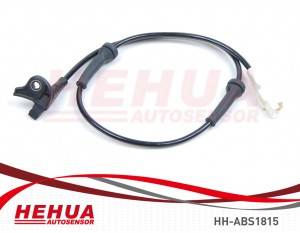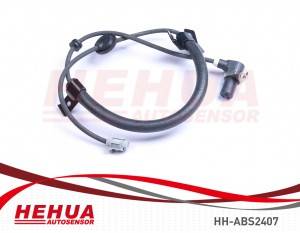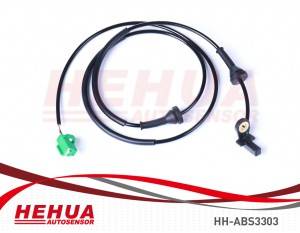ABS Sensor HH-ABS1815
HEHUA NO.: HH-ABS1815
OEM NO.:
454588
96353847
96436596
96436977
96449667
96386487
9644966780
0265007423
FITTING POSITIME:FRONT AXLE LEFT AND RIGHT
APPLICATION:
PEUGEOT307 (3A/C) (2000/08 – /)
307 (3A/C) 1.6 16V NFU (TU5JP4) 1587 80 109 Hatchback 00/08 – /
307 (3A/C) 2.0 16V RFN (EW10J4) 1997 100 136 Hatchback 00/08 – /
307 (3A/C) 2.0 HDi 90 RHY (DW10TD) 1997 66 90 Hatchback 00/08 – /
307 (3A/C) 2.0 HDi 110 RHS (DW10ATED) 1997 79 107 Hatchback 00/08 – /
307 (3A/C) 1.4 KFW (TU3JP) 1360 55 75 Hatchback 00/08 – /
307 (3A/C) 1.4 HDi 8HZ (DV4TD) 1398 50 68 Hatchback 01/10 – /
307 (3A/C) 2.0 HDi 135 RHR (DW10BTED4) 1997 100 136 Hatchback 03/10 – /
307 (3A/C) 1.4 16V KFU (ET3J4) 1360 65 88 Hatchback 03/11 – /
307 (3A/C) 1.6 HDi 110 9HZ (DV6TED4) 1560 80 109 Hatchback 04/02 – /
307 (3A/C) 2.0 16V RFJ (EW10A) 1997 103 140 Hatchback 05/03 – /
PEUGEOT307 SW (3H) (2002/03 – /)
307 SW (3H) 2.0 HDi 135 RHR (DW10BTED4) 1997 100 136 Estate 04/02 – /
307 SW (3H) 2.0 16V RFJ (EW10A) 1997 103 140 Estate 05/03 – /
307 SW (3H) 1.4 KFW (TU3JP) 1360 55 75 Estate 02/04 – 03/09
307 SW (3H) 1.4 16V KFU (ET3J4) 1360 65 88 Estate 03/11 – /
307 SW (3H) 1.6 16V NFU (TU5JP4) 1587 80 109 Estate 02/03 – /
307 SW (3H) 2.0 16V RFN (EW10J4) 1997 100 136 Estate 02/03 – /
307 SW (3H) 2.0 HDI 90 RHY (DW10TD) 1997 66 90 Estate 02/03 – /
307 SW (3H) 2.0 HDI 110 RHS (DW10ATED) 1997 79 107 Estate 02/03 – /
PEUGEOT307 CC (3B) (2003/10 – /)
307 CC (3B) 2.0 16V RFN (EW10J4) 1997 100 136 Convertible 03/10 – /
307 CC (3B) 2.0 16V RFK (EW10J4S) 1997 130 177 Convertible 03/10 – /
307 CC (3B) 2.0 16V RFJ (EW10A) 1997 103 140 Convertible 05/03 – /
307 CC (3B) 1.6 16V NFU (TU5JP4) 1587 80 110 Convertible 05/02 – /
PEUGEOT307 Break (3E) (2002/03 – /)
307 Break (3E) 2.0 HDI 110 RHS (DW10ATED) 1997 79 107 Estate 02/03 – /
307 Break (3E) 1.4 KFW (TU3JP) 1360 55 75 Estate 02/04 – 03/09
307 Break (3E) 1.4 HDi 8HZ (DV4TD) 1398 50 68 Estate 02/03 – /
307 Break (3E) 2.0 16V RFJ (EW10A) 1997 103 140 Estate 05/03 – /
307 Break (3E) 2.0 RFN (EW10J4) 1997 100 136 Estate 02/03 – /
307 Break (3E) 2.0 HDi 135 RHR (DW10BTED4) 1997 100 136 Estate 04/02 – /
307 Break (3E) 1.4 16V KFU (ET3J4) 1360 65 88 Estate 03/11 – /
307 Break (3E) 1.6 16V NFU (TU5JP4) 1587 80 109 Estate 02/03 – /
307 Break (3E) 2.0 HDI 90 RHY (DW10TD) 1997 66 90 Estate 02/03 – /
ABS SENSOR Operating principle
The wheel speed sensors are positioned directly above the impulse wheel, which is connected to the wheel hub or drive shaft. The pole pin, surrounded by a winding, connects to a permanent magnet whose magnetic effect extends to the pole wheel. The rotation of the impulse wheel and the resulting switching from tooth to tooth space brings about a change in the magnetic flow caused by the pole pin and winding. This changing magnetic field induces a quantifiable, or measurable alternating voltage in the winding.
The frequency and amplitudes of this alternating voltage are in relation to the wheel speed. Inductive passive sensors do not require a separate power supply from the control unit. Since the signal range for signal detection is defined by the control unit, the amplitude level must be within a specific voltage range. Gap (A) between sensor and impulse wheel is provided by way of the axle design.
Inductive speed sensor, passive sensors
Inductive passive sensors
Active wheel speed sensors
Operating principle
The active sensor is a proximity sensor with integrated electronics that is supplied with a defined voltage from the ABS control unit. A multipole ring can be used as an impulse wheel while at the same time being integrated in a sealing ring of a wheel bearing. Inserted in this sealing ring are magnets with alternating pole directions. The magneto-resistive resistors integrated in the electronic circuit of the sensor detect an alternating magnetic field when the multipole ring rotates. This sinusoidal signal is converted by the electronics in the sensor into a digital signal. It is then transferred to the control unit as a current signal using the pulse-width modulation method.
The sensor is connected to the control unit via a two-pole electric connecting cable. The sensor signal is also transmitted at the same time over a power supply line. The other line is used as a sensor ground. In addition to magneto-resistive sensor elements, nowadays Hall sensor elements are also fitted that permit a larger air gap and respond to the smallest of changes in the magnetic field. If a steel impulse wheel is installed in a vehicle in place of a multipole ring, a magnet is also affixed to the sensor element. When the impulse wheel turns, the constant magnetic field in the sensor changes. The signal processing and IC are identical to the magneto-resistive sensor.
Active wheel speed sensors
Active wheel speed sensors: Advantages of active sensors
Active sensors
ADVANTAGES OF ACTIVE SENSORS
Wheel speed detection from standstill. This facilitates speed measurements down to 0.1 km/h, whi









